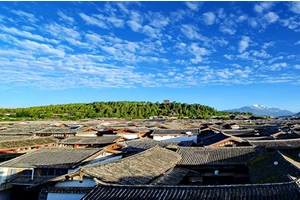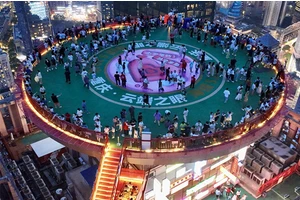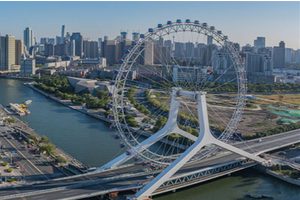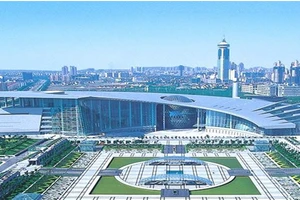Poverty alleviation through tourism
Tourism poverty alleviation is a brand-new poverty alleviation model, that is, a regional economic development model that promotes regional economic development by supporting tourism development in poverty-stricken areas with good tourism resources, and then gets rid of poverty and becomes rich. The effect of tourism poverty alleviation depends on the "internal strength" of self-development in poverty-stricken areas in a larger scope and at a higher level. Of course, poor areas can only develop their tourism economy with effective external support.
Significance of tourism poverty alleviation and development
As a development-oriented poverty alleviation with less investment, faster recovery, low rate of returning to poverty and high effect, the significance of tourism poverty alleviation and development is multifaceted.
1. It can realize the communication between urban and rural areas and between regions, and then realize the inter-provincial communication and even the international communication.
2. It can realize the communication between industries, develop aquaculture, planting and food processing industries in poverty-stricken areas through tourism poverty alleviation and development, and support village-run factories, construction companies and stone processing factories with local resources as the mainstay, so as to cultivate new economic growth points and leading industries and improve the industrial structure in poverty-stricken areas.
3. It can realize information dissemination and lifestyle exchange, promote the poor people to update their concepts, enhance their awareness of market economy, gradually enable the poor people to establish their thinking and working methods that are compatible with modern civilization and commodity economy, and lay an ideological and talent foundation for the development of poor areas.
4. It can expand employment, improve employment opportunities, help to resettle rural surplus labor, reduce the blind outflow of migrant workers, eliminate social unrest factors, and play an exemplary and leading role in solving employment problems for people in poverty-stricken areas around.
5. It can help poor areas to improve the investment environment, promote horizontal economic integration, expand their opening up, and promote social and economic progress in poor areas.
6. It can protect the environment and resources in poverty-stricken areas, reverse its deteriorating trend and realize the long-term goal of sustainable development.
Problems existing in tourism poverty alleviation and development
1. No planning and development. The development of tourism in poverty-stricken areas is mostly done spontaneously by local people in order to "cure poverty", lacking effective theoretical guidance of development model, without careful consideration, but following their feelings. Insufficient attention is paid to project development, which is manifested in blindness, not paying attention to the use of scientific theories to guide the development of tourism resources, and the phenomenon of random development, low-grade development, repeated development and even indiscriminate development is more common; Development without planning, non-compliance with planning and low-level planning occur from time to time, resulting in disorder of development and construction. Ignoring market analysis in product design is imitative, which leads to the similarity of projects, products, markets and customers. In the long run, it will not only fail to develop the local economy, but will bear a heavy economic burden.
2. The infrastructure is backward. Infrastructure is the hardware for developing tourism in poor areas. "Old, young, marginal and poor" has always been synonymous with poverty-stricken areas, and all infrastructure facilities are relatively backward. The backwardness of tourism infrastructure and supporting service facilities is a bottleneck restricting the development of tourism in poor areas for a long time. For example, the backward transportation facilities have caused the number of tourists in poor areas to be less for a long time, so that the rich tourism resources can not be effectively developed, and the developed tourism products can not be displayed to tourists more quickly, and ultimately can not promote the effective development of poor areas.
3. Insufficient and single funds. To develop tourism, capital is the key. Poverty-stricken areas with rich tourism resources do not have enough funds to develop them, and many resources are still "shelved" and "kept in boudoir" so far, failing to become characteristic tourism products. Moreover, in most areas, government and collective investment are still the main investment in tourism poverty alleviation, while enterprises, individuals and foreign capital have low or no investment; Limited investment has long been focused on basic reception such as transportation, accommodation and food, while insufficient funds have been invested in purchasing and entertainment with the largest flexible income, resulting in obvious extensive and primary tourism development. 4. Lack of professionals. Insufficient development of tourism human resources is the fundamental factor that restricts the development of tourism in poor areas. The low cultural quality of the population restricts the development of tourism in poor areas mainly in the lack of specialized technical personnel. For example, in the tour guide link, due to the lack of talents, the employment standard has to be lowered, and a large number of "crash" tour guides have been employed. Some tour guides not only lack basic knowledge of history, culture and physical geography, but also lack knowledge of local culture and physical geography. It has affected the effective development of tourism in poor areas.
5. Pay more attention to development than protection. The inheritance of ecological environment and local cultural resources is the premise of tourism development and development in poor areas. People in some poor areas are eager to get rid of poverty, driven by interests, eager for quick success and instant benefit, short-sighted, only developing without protecting, only using without investing. Taking predatory development means at the expense of natural resources and local environment is reflected in the planning, which is full of business design ideas such as quantitative indicators and profit maximization, instead of setting multiple goals and pursuing comprehensive benefits. Reflected in practice, it shows that in the process of development, it is unscrupulous and exhausted, blindly increasing passenger flow, expanding tourism scale, placing environmental protection in a dispensable position, ignoring the protection of natural and human environment and the sustainable utilization of resources, and the result will be disastrous.
6. Residents benefit unevenly. How the poor people benefit from tourism development and increase their development opportunities is the core issue of tourism poverty alleviation. At the beginning of developing tourism in poor areas. All the local residents treat the swarming investors and tourists with a welcome attitude, and the local government is also willing to provide all kinds of support, because the development of tourism will bring considerable economic benefits. However, in the process of development and operation, with the development of tourism accompanied by the surge of tourists, only a few local residents are used as cheap labor, engaged in the lowest-level work, and it is difficult to enter the management level. A large number of local residents are excluded from tourism activities and cannot directly benefit from tourism development. The real benefits are concentrated in the hands of a few developers and managers. The development of poor people has not really become the focus of tourism poverty alleviation and development, and has not achieved the goal of helping and supporting vulnerable groups.
Countermeasures adopted by tourism poverty alleviation and development
1. Government-led. The development of tourism in poor areas has a poor foundation and a thin foundation, so it is necessary to give full play to the role of the government in tourism poverty alleviation. In the construction of tourism infrastructure, the government should play the leading role, and the government departments in poor areas should focus on infrastructure such as transportation and communication, so as to completely change the backward traffic situation in poor areas and eliminate the biggest obstacle to the development of tourism in poor areas; In the aspect of legal environment construction, the government should formulate local tourism laws and regulations, understand the development of tourism poverty alleviation from the height of tourism according to law, change the phenomenon of emphasizing development but neglecting protection, put an end to destructive development, realize the harmonious development between man and nature in poverty-stricken areas, and provide a good legal environment for the rational and effective development of tourism poverty alleviation; In terms of market mechanism, the government should be market-oriented in the development of tourism poverty alleviation, and according to the principle of fair competition in the market economy, no matter state-owned, collective or individual, they should establish and improve the market mechanism through normal market competition to meet the urgent needs of economic development in poor areas.
2. Planning first. Tourism planning is the program and blueprint of tourism development and an important condition for promoting the healthy development of tourism. The fragility and non-renewability of tourism resources determine that the development of tourism in poverty-stricken areas must be systematically investigated, scientifically planned, rationally designed, selected with a good development model, and developed by relying on resources and markets, so as to truly put the tourism economy in poverty-stricken areas on a virtuous development track. However, rushing headlong into the herd, seeking quick success and instant benefit, exhausting resources and simply and extensively developing without planning will seriously damage the fragile ecological environment and make it difficult for tourism to help the poor maintain its sustainable development.
3. Diversified funds. The shortage of funds has always been an important factor restricting the deep development of tourism poverty alleviation. With the vigorous development of tourism economy, the scope and scale of government investment in tourism are becoming more and more limited. The development of tourism cannot rely entirely on government funds, but requires the efforts of all sectors of society. We should adhere to the principles of "five together" and "who invests, manages, manages and benefits" for individuals, collectives, units, governments and foreign investors, formulate preferential policies to attract investment, and improve the enthusiasm of all parties to invest in tourism. At the same time, tourist destinations in poverty-stricken areas should broaden their income sources, constantly expand their service areas, expand their business scope, increase tourists' consumption expenses such as shopping and entertainment, expand the sales revenue of tourism by-products and realize diversified income; Efforts should be made to improve the management and construction level, promote the development of tourist destinations from leisure sightseeing to holiday residence, and from single development to comprehensive development, so as to improve the comprehensive income level.
4. Talent cultivation. From the perspective of human resources development and management, the key to cultivating professional talents for tourism development in poor areas lies in establishing an effective human resources allocation mechanism. Use and develop local human resources as much as possible, actively guide, do a good demonstration, create a good environment and conditions, make local talents stand out, and select young cadres with high education and pioneering spirit to enter the tourism leading group. Cultivate and develop compound tour guide talents who know both local culture and tourism, adhere to certificates, advocate people-oriented, and constantly improve the quality of tourism managers and other personnel.
5. find the right features. Characteristics are the soul of tourism development and the embodiment of the vitality of tourism products. Therefore, tourism poverty alleviation and development should be open-minded, dare to innovate, highlight their own personality and characteristics, and never learn from others. Beautiful, unique landscapes and unique folk customs are local characteristics. These characteristic products should form complementary advantages with the tourism resources in the surrounding areas, so as to achieve "harmony but difference", meet the psychological and spiritual needs of tourists in pursuing truth, goodness and beauty from all angles and at all levels, stimulate people's travel motivation and generate strong tourism attraction. To a certain extent, there is benefit with characteristics, and there is development with characteristics.
6. Supporting development. Tourism activities include six elements: "travel, travel, housing, food, shopping and entertainment". Only by doing a good job in supporting the development of tourism poverty alleviation can the grade, grade, reception capacity and income-generating capacity of tourist attractions be comprehensively improved. While constantly enriching and optimizing sightseeing projects, we should do a good job in the construction and operation of infrastructure such as accommodation, catering and shopping; It is necessary to give full play to the unique advantages of local songs and dances, folk customs, culture and other aspects and show them to tourists in different ways; It is necessary to develop characteristic tourism agriculture around the needs of tourists to eat, buy and take, and develop tourism industry with resource base and local characteristics around the needs of tourism supplies, souvenirs and handicrafts. This not only meets the needs of tourists, but also promotes the economic development of poor areas.
7. Mass participation. The masses are not only the object of poverty alleviation through tourism, but also the new force to participate in tourism. Tourism poverty alleviation and development should fully consider the interests of local people and create a good environment and conditions for local people to enter and participate in tourism business activities. Take inspiration, enlightenment, typical driving and other ways to guide the masses to use the existing conditions to carry out tourism management, set up family hotels, and participate in the processing and sale of local native products. In order to mobilize the enthusiasm of the masses to participate in the tourism industry, when leasing tourism resources to developers, local people should own certain shares in the resources. The participation of local people can not only enhance the unique local cultural atmosphere, improve the attractiveness of resources, but more importantly, let local people really benefit from tourism, which not only embodies the interests of the masses, realizes the function of poverty alleviation through tourism, but also helps the masses to actively protect the ecological environment.
8. Focus on supporting ambition. Tourism poverty alleviation can not be limited to material poverty alleviation, but more importantly, ideological and conceptual poverty alleviation. The purpose of developing tourism is to make the economy, culture and spiritual outlook of poor areas develop in an all-round way. The implementation of poverty alleviation through tourism has changed people's old ideas and enhanced their awareness of market economy. However, due to the lack of corresponding spiritual civilization construction and ideological education, the social environment has deteriorated, and the phenomena of chasing and selling, cheating and stealing have occurred from time to time, which has seriously damaged the image of tourist destinations and made many tourists flinch. Therefore, if poverty alleviation is only achieved from materials, tourism poverty alleviation has not achieved complete success. In the implementation of tourism poverty alleviation, on the one hand, we should strengthen the construction of legal system, on the other hand, we should make the masses establish a sense of market service. Only by changing people's mental outlook can we improve the service environment, thus attracting more tourists and forming a virtuous circle.
9. Strengthen services. According to the requirements of Scientific Outlook on Development, the implementation of tourism poverty alleviation and development should, of course, focus on economic benefits and accelerate local farmers to get rid of poverty and become rich, but at the same time, we must give priority to the protection of resources and environment, seek the coordinated development of tourism with nature, culture and human living environment, and achieve the unity of economic and social goals. All kinds of tourism resources must be developed under the premise of protection, and protection should be strengthened during development, so as to achieve strict protection and rational development, and prevent the ecological environment from being destroyed and the humanistic characteristics from being degraded and lost. Tourism poverty alleviation and development must emphasize primitiveness, naturalness and ecologicalization. From plant protection to landscape facilities and service facilities, we must adhere to the principles of ecology and environmental protection, and create an environmental atmosphere that returns to nature and pursues simplicity.
With the development of tourism, it will bring about the movement and redistribution of domestic property, and tourism has realized the transfer of wealth from developed areas to underdeveloped areas. Many people in tourist areas can benefit from the direct income of tourism. In 1991, Guizhou province creatively put forward the concept of "tourism to help the poor", which has achieved some practical results in recent years. First, farmers around the scenic spot generally get rid of poverty and become rich; Second, it enlivened the rural economy; Third, it has injected new vitality into the county economy and promoted the rapid development of other industries. According to incomplete statistics, more than 3 million people have been lifted out of poverty and become rich through tourism development in China, and tourism has played a prominent role in lifting poverty and becoming rich. At present, the upsurge of tourism poverty alleviation and development in China is in the ascendant. Document No.9 of the State Council fully affirmed the poverty alleviation function of tourism, and clearly proposed to plan and build a number of pilot areas for poverty alleviation through tourism. In 2000, with the strong support of the State Council Poverty Alleviation Office, the National Tourism Administration set up the first national-level tourism poverty alleviation experimental zone-Liupanshan Tourism Poverty Alleviation Experimental Zone in Xihaigu, Ningxia, which is known as the "crown of poverty" in China. Subsequently, a number of national and provincial pilot tourism poverty alleviation zones were established one after another, and many poor counties and even villages made full use of their unique tourism resources to start tourism. At present, many places in central and western China, such as Yunnan, Xinjiang, Sichuan, Guizhou, Tibet, Hunan, Hubei, Henan, Shaanxi and Shanxi, have developed a large number of tourism resources, which have played an important role in promoting local economic development.






